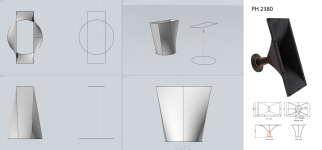Hello - I'm looking for some guidance from anyone who has seen this wave guide in person (or the JBL 2380A).
I'm modelling the wave guide at the moment with the aim of getting it CNCd from MDF and integrated into the baffle of the speaker i'm building so it looks seamless - only thing is, there has been some guess work on my part as I haven't laid eyes on one in real life.
My question is, is my construction of the base (where the driver attaches) to the top of the throat, correct, see image attached.
Thanks for any help,
Steve
I'm modelling the wave guide at the moment with the aim of getting it CNCd from MDF and integrated into the baffle of the speaker i'm building so it looks seamless - only thing is, there has been some guess work on my part as I haven't laid eyes on one in real life.
My question is, is my construction of the base (where the driver attaches) to the top of the throat, correct, see image attached.
Thanks for any help,
Steve
Attachments
Steve,
Yours doesn't look right, vertically too short and too wide.

The JBL 2380A diffraction slot appears to be about 1" wide, 4.5" tall.

It's throat expands from ~3.14 square inches to ~4.5 square inches at the diffraction slot.
Your vertical expansion looks to be straight. Not 100% positive, but I think the vertical arc radius of the throat section matches the initial portion of the bi-radial horn.

I think the only part of the horn without a curve is the mounting flange.
Art
Yours doesn't look right, vertically too short and too wide.
The JBL 2380A diffraction slot appears to be about 1" wide, 4.5" tall.
It's throat expands from ~3.14 square inches to ~4.5 square inches at the diffraction slot.
Your vertical expansion looks to be straight. Not 100% positive, but I think the vertical arc radius of the throat section matches the initial portion of the bi-radial horn.
I think the only part of the horn without a curve is the mounting flange.
Art
